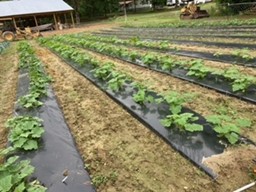Okay, okay so it is hot! What is new about that that? It is always hot in July. The funny part is, why are the weather reporters always surprised when July is hot? We as gardeners should never be surprised by the heat and the humidity in Georgia this time of year. Nor should we neglect the dry gardens as summer progresses. Because as we know the dry hot of July will inevitably lead to the dog (or Dawg) days of August. In this article we attempt to ask the what, when, where, how and why of hot summer gardening.
The ‘what’ of July gardening is pretty simple. The main goals should be to maintain and prepare. Maintain what is in the garden by keeping it moist and keeping destructive weeds/animals out. Prepare for a fall harvest. These seem like simple year-round gardening tips and they are, but in the month of July, let’s be honest, we neglect this due to the heat. It is wwwaaayyy more comfortable in the air conditioning than outside in the heat. What vegetables can we prepare? How about broccoli or cabbage or kale or lettuce or spinach? Start these indoors from seed in July to be planted in August and grown for fall harvest.
The ‘when’ for July has several things pertaining to maintain and prepare. Our bodies react in a similar fashion as plants do to extremes. For example, in the heat of the day if someone throws water on you, at first it is a relief, but as that water dries and turns to vapor it can become pretty miserable (hot and sticky) to take the analogy a little farther. Water on the outside of the body can be refreshing and cool down the skin but that is only temporary, while us drinking water is life giving, without it we humans cannot live. Plants have a similar reaction. For plants water is drawn from the root system upwards to its stems, leaves, flowers, and fruits. If the water dries quickly on the outside, due to the heat, then there is no benefit to the plant. The water may cool the leaves and the outer parts of the plant but no benefit is incurred to the plant as a whole. The best plan is to water early in the morning or late in the evening when the whole plant benefits from the moisture.
The ‘where’ in this equation is probably the easiest to answer. Plant and grow where the plants have already started or have been in place in the past. July is not the best time to start a new area for planting. Do that in September or October. In July, prepare for next season. Make use of interior space where conditions can be better controlled and relief from the heat for sensitive plants.
‘How’ is the most interesting and perplexing part of July planting. The many ways to complete the task are wide and varied. Some are as simple as working daily to weed and water different areas. Split the garden into workable sections then there is less exposure to the elements and heat. Others have to do with water systems and timers to calculate when watering should occur to get optimal exposure to the plants. But then there are systems like * Plasticulture using drip tape/plastic covering to secure the soil and moisture to keep it contained in a certain area. This system helps to keep weeds at bay and helps with the irrigation process. In speaking to a local Dallas, Georgia farmers, Lloyd & Sharon Holt and their daughter Michaela of Southern Girls Market and Hidden Hollow Farm they use this system, during the hot months, in order to better control the areas around their products they take to market.

‘Why’ is really self-explanatory. If we do not take the month of July to maintain and prepare then the fall harvest will never happen. These months of heat and humidity have a role to play in the plan for planting. Use these months wisely and carefully to prepare for future harvest by maintaining the existing crops/plants. Always stay hydrated and keep cool during these hot months!